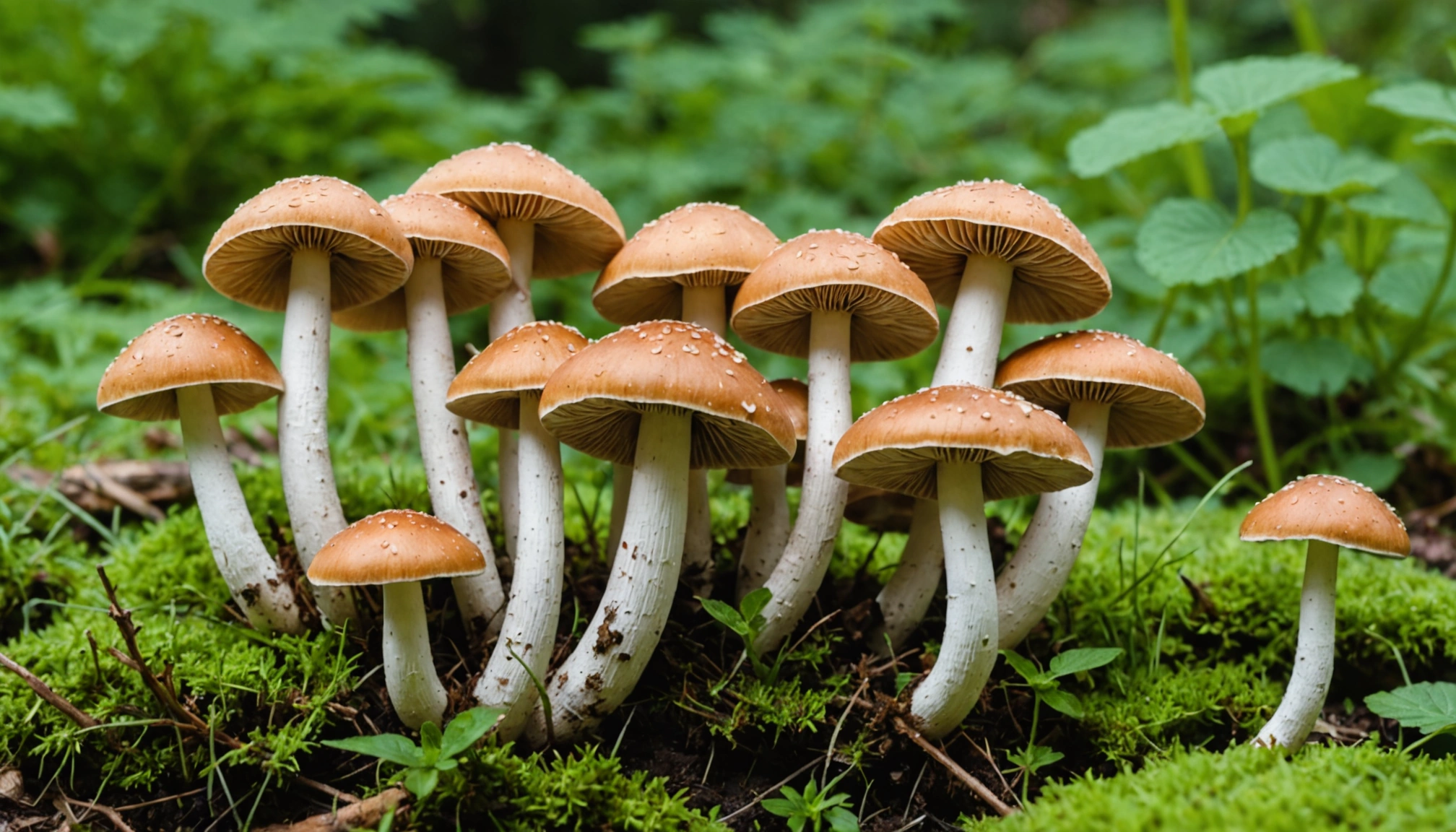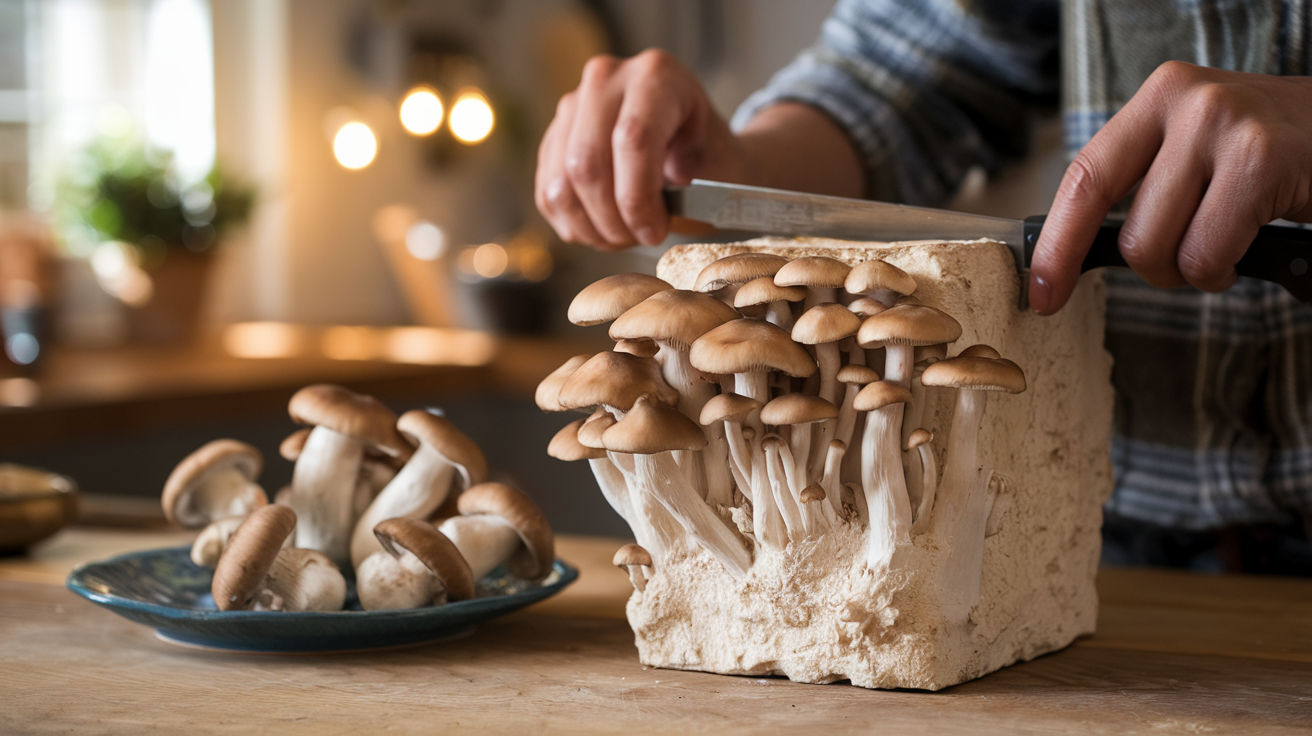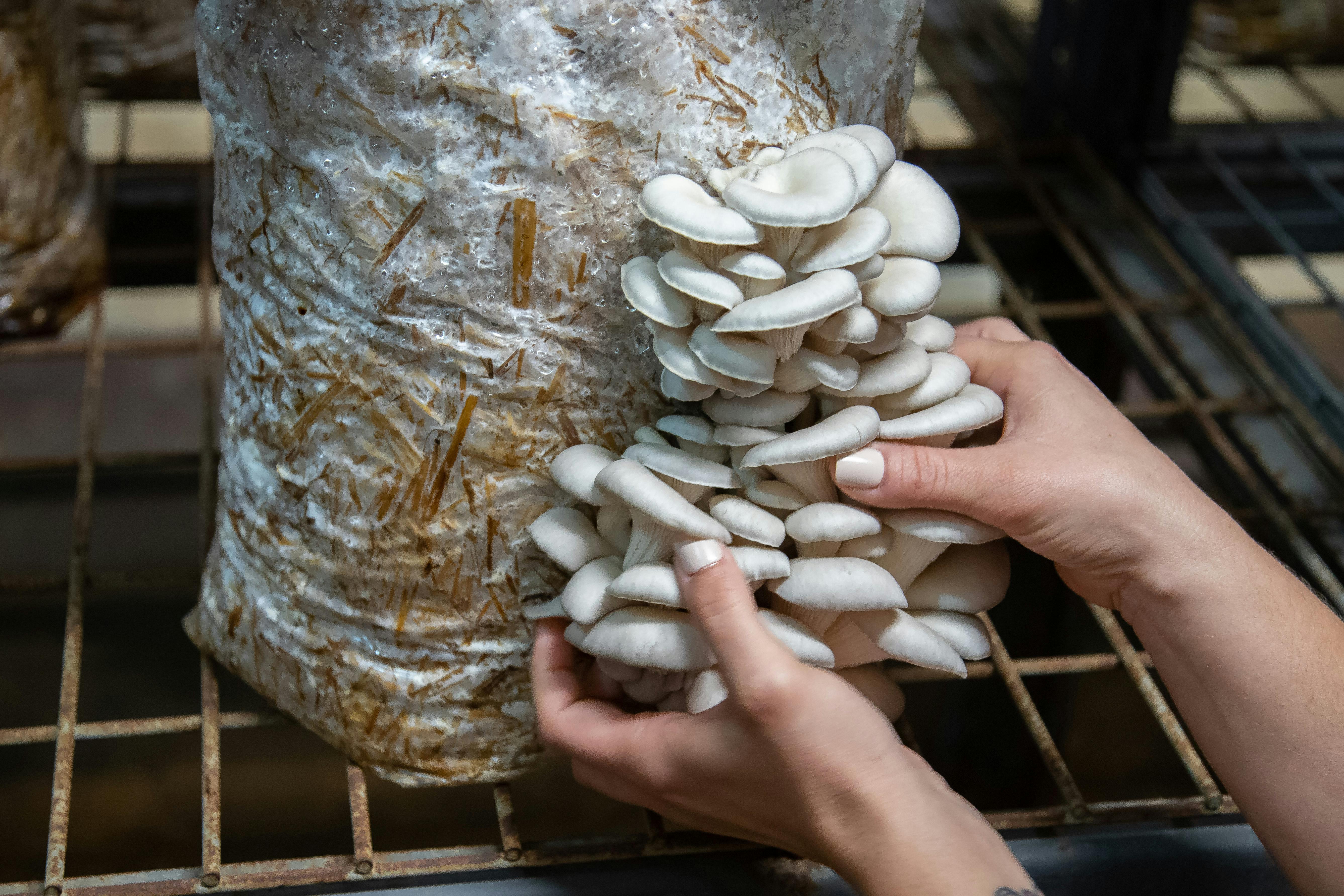
Are you interested in growing your mushrooms at home? Unravel the secrets behind cultivating a variety of extraordinary fungi and discover a plethora of health benefits they offer. From the earthy flavors of Portobello to the elusive Morel, each mushroom boasts unique allure and nutritional value waiting to be unearthed. Get ready to enjoy a bountiful harvest of delicious mushrooms with our recommended guide, “10 Best Mushrooms to Grow at Home: How to Cultivate & Their Health Benefits.” We even help you choose the right kits and select the appropriate grow bags. Whether you’re an experienced gardener or an inquisitive beginner, this guide will help you successfully nurture these mushrooms in your own indoor space. Prepare to elevate your culinary experiences and well-being through the enchantment of mushroom cultivation!

The Top 10 Mushrooms to Cultivate
Oyster Mushrooms (Pleurotus ostreatus)
Oyster mushrooms are versatile and easy to grow, making them a popular choice for beginners in mushroom cultivation. They have a mild flavor and a delicate texture, making them perfect for a variety of culinary dishes. Oyster mushrooms come in different varieties, including pink, yellow, and blue oysters, each with its unique flavor profile and appearance.
Shiitake Mushrooms (Lentinula edodes)
Shiitake mushrooms are well-known for their rich, umami flavor. They are used in a wide range of Asian dishes and are packed with nutrients and health benefits. Shiitakes are not only delicious but also have medicinal properties, known for their immune-boosting and cholesterol-lowering effects.
Lion’s Mane Mushrooms (Hericium erinaceus)
Lion’s Mane mushrooms have a unique appearance with cascading spines. They are believed to have neuroprotective properties and are known for their lobster-like flavor. Research suggests that Lion’s Mane mushrooms may support brain health and cognitive function, making them a popular choice for those seeking natural nootropic benefits.
Button Mushrooms (Agaricus bisporus)
Button mushrooms are one of the most commonly cultivated mushrooms worldwide. They have a mild flavor and are great for adding a savory touch to various dishes. Button mushrooms are versatile and can be enjoyed raw in salads, sautéed as a side dish, or used in stews and soups for added depth of flavor.
Portobello Mushrooms (Agaricus bisporus, mature stage)
Portobello mushrooms are mature button mushrooms that have a meaty texture and a robust flavor. They are often used as a meat substitute in vegetarian dishes. When grilled or roasted, Portobellos develop a smoky flavor, making them a favorite choice for vegetarian burgers, sandwiches, and grilled dishes.
Reishi Mushrooms (Ganoderma lucidum)
Reishi mushrooms have a long history of medicinal use in traditional Chinese medicine. They are known for their bitter taste and are often consumed in supplement form for their health benefits. Reishi mushrooms are revered for their potential immune-boosting properties, stress-reducing effects, and anti-inflammatory abilities.
Enoki Mushrooms (Flammulina velutipes)
Enoki mushrooms have long, slender stems and small caps. They have a mild, slightly crunchy texture and are commonly used in soups, salads, and stir-fries. Enoki mushrooms are low in calories and rich in nutrients like fiber, potassium, and antioxidants, making them a healthy addition to various dishes.
Maitake Mushrooms (Grifola frondosa)
Maitake mushrooms, also known as hen-of-the-woods, have a distinct frond-like appearance. They have a rich, earthy flavor and are prized for their culinary and medicinal properties. In addition to their savory taste, Maitake mushrooms are believed to have immune-boosting and blood sugar-regulating effects, making them a valuable ingredient in holistic wellness practices.
Morel Mushrooms (Morchella spp.)
Morel mushrooms are highly sought after for their distinctive, nutty, and earthy flavor, as well as their unique appearance. They are considered a gourmet delicacy and are often foraged in the wild. Morels are prized by chefs for their complex flavor profile and are featured in upscale dishes like creamy pastas, risottos, and sauces, adding a luxurious touch to culinary creations.
Chanterelle Mushrooms (Cantharellus spp.)
Chanterelle mushrooms have a delicate, fruity aroma and a mild, peppery flavor. Chefs prize them for their culinary versatility and often feature them in upscale dishes. Chanterelles pair well with various ingredients like garlic, herbs, and cream, adding a gourmet touch to dishes like omelets, pasta, and sauces, elevating the overall dining experience.
How to Successfully Grow Mushrooms
Selecting the Right Mushroom Species for Cultivation
Choosing the Perfect Mushroom Species for Your Cultivation Project.
Selecting the right mushroom species is the first crucial step towards a successful mushroom growing venture. With a wide variety of mushrooms to choose from, such as Oyster, Shiitake, Lion’s Mane, Button, Portobello, Reishi, Enoki, Maitake, Morel, and Chanterelle, it’s essential to understand the unique characteristics and growth requirements of each species. Dive deeper into the world of mushrooms to determine the best fit for your cultivation setup.
Choosing Suitable Growing Mediums
Exploring the Best Growing Mediums for Your Mushroom Garden.
The choice of growing medium significantly impacts the growth and yield of your mushrooms. Consider experimenting with mediums like straw, wood chips, sawdust, and compost to find the most suitable option for the specific mushroom species you’ve selected. Each medium has its advantages and ideal applications, so understanding their properties is essential for successful mushroom cultivation.
Creating and Maintaining Optimal Growing Conditions
Optimizing the Growth Environment for Healthy Mushroom Development.
Maintaining optimal growing conditions is essential to ensure healthy mushroom development. Factors such as humidity levels, temperature control, light exposure, and proper air circulation play a crucial role in the growth process. By creating an environment that mimics the natural habitat of your chosen mushrooms, you can significantly increase your chances of a successful harvest.
Harvesting Techniques and Proper Storage
Mastering the Art of Harvesting and Storing Your Mushrooms.
Harvesting mushrooms at the right time using the correct techniques is vital for preserving their quality and flavor. Explore the best practices for harvesting different mushroom species to maximize your yield. Additionally, learn how to store harvested mushrooms properly to extend their shelf life and maintain their freshness. With proper harvesting and storage techniques, you can enjoy your homegrown mushrooms for longer periods.
Successful mushroom cultivation requires careful consideration of the mushroom species, growing mediums, environmental conditions, and harvesting practices. By following these guidelines and continuously learning about mushroom cultivation, you can enhance your skills and achieve a rewarding harvest of delicious, homegrown mushrooms.

Mushrooms: Nature’s Nutrient Powerhouse
Mushrooms, often considered a culinary delight, are not only a flavorful addition to dishes but also a powerhouse of nutrients with remarkable health benefits.
Nutritional Value and Health-Boosting Properties.
Mushrooms are a low-calorie food packed with essential nutrients vital for overall well-being. They are an excellent source of vitamin D, crucial for bone health, selenium, an antioxidant mineral, and various B vitamins essential for energy metabolism. Additionally, mushrooms are rich in antioxidants and fiber, promoting digestive health and adding a satiating element to meals. The fiber in mushrooms also supports gut health by aiding digestion and encouraging the growth of beneficial gut bacteria.
Potential Health Benefits.
Beyond their nutritional value, mushrooms offer a spectrum of potential health benefits. Studies suggest that mushrooms can enhance immune function, reduce inflammation, and support weight maintenance. Certain mushroom varieties, such as shiitake and reishi, have been studied for their anti-cancer properties, highlighting the diverse health-promoting compounds present in these fungi. Moreover, mushrooms contain beta-glucans, compounds known for their immune-boosting properties, which can help the body defend against infections and diseases.
Positive Environmental Impact of Mushroom Cultivation.
Embracing mushrooms extends beyond personal health benefits to encompass environmental sustainability. Mushroom cultivation stands out for its eco-friendly nature, utilizing agricultural by-products such as straw and wood chips. Furthermore, mushrooms play a vital role in nutrient recycling and soil enrichment, contributing positively to ecosystem health. The cultivation of mushrooms also requires less water and land compared to traditional livestock farming, making it a more sustainable food option.
Cost-Effectiveness and Culinary Significance.
In addition to their health and environmental advantages, mushrooms are a cost-effective and versatile ingredient in culinary endeavors. Widely available and affordable, mushrooms offer a unique umami flavor to dishes, elevating the taste profile of various cuisines. Their meaty texture makes them a popular choice for vegetarian and vegan diets, providing a satisfying alternative to traditional protein sources. Additionally, mushrooms are low in sodium and calories, making them a healthy ingredient for those looking to manage their weight and overall health.
Integrating mushrooms into your diet not only enhances your health with a spectrum of nutrients and potential benefits but also aligns with sustainable food practices. By savoring the goodness of mushrooms, you embark on a journey towards holistic well-being, one delectable bite at a time. Make sure to explore the diverse varieties of mushrooms available and experiment with incorporating them into various dishes to reap their full nutritional and culinary benefits.
Mushroom Cultivation Techniques and Innovations
When it comes to mushroom cultivation, a rich history of traditional methods has been practiced for centuries. However, in recent times, modern techniques and innovative approaches have revolutionized the industry. This section will compare traditional and modern cultivation methods, explore the latest innovative approaches in mushroom farming, and discuss future trends shaping the field of mushroom cultivation.
Traditional vs. Modern Cultivation Methods
The Age-Old Practices: Exploring the traditional methods of mushroom cultivation that have been passed down through generations. From using composting techniques to natural substrate inoculation, these methods have proven effective over time.
Embracing Technology: With the advent of modern technology, mushroom cultivation has seen significant advancements. From climate-controlled growing environments to automated harvesting systems, modern techniques have increased efficiency and yields.
Innovative Approaches to Mushroom Farming
Vertical Farming: One innovative approach gaining traction in mushroom cultivation is vertical farming. By utilizing vertical space, growers can maximize production in limited areas while reducing their environmental footprint.
Mycelium Applications: The use of mycelium, the root structure of mushrooms, is another innovative approach that is being explored. From sustainable packaging materials to alternative protein sources, mycelium-based products are paving the way for a new wave of possibilities.
Future Trends in Mushroom Cultivation
Biotechnological Advancements: The future of mushroom cultivation lies in biotechnological advancements. From gene editing for enhanced traits to biofortification, the field is poised for groundbreaking developments.
Circular Economy Practices: As sustainability becomes a key focus, future trends in mushroom cultivation are leaning towards circular economy practices. From upcycling agricultural waste to creating closed-loop systems, the industry is moving towards a more sustainable future.
The Mushroom Cultivation Landscape
The mushroom cultivation landscape is rapidly evolving, driven by a mix of tradition, innovation, and future-oriented practices. Growers today have the advantage of integrating age-old wisdom with cutting-edge technology to optimize their yields and environmental impact. Traditional methods, rooted in knowledge passed down through generations, provide a solid foundation for sustainably cultivating mushrooms.
Modern advancements have brought about a paradigm shift in cultivation practices. Climate-controlled environments provide optimal growing conditions, enabling year-round production and higher yields. Automated systems streamline processes, reducing manual labor and increasing efficiency. These technological innovations have not only boosted productivity but also opened doors to new possibilities in mushroom farming.
Innovative approaches are reshaping the way mushrooms are cultivated. Vertical farming, a practice that utilizes vertical space to grow mushrooms, is gaining popularity due to its space-efficient nature. By stacking growing beds vertically, growers can maximize their output while minimizing their environmental footprint. Mycelium applications, leveraging the versatile properties of mushroom roots, are revolutionizing industries beyond food production. From biodegradable packaging to sustainable textiles, mycelium-based products represent a sustainable alternative to traditional materials.
Looking ahead, the future of mushroom cultivation is bright, with biotechnological advancements at its core. Genetic editing techniques promise mushrooms with enhanced traits such as increased resistance to pests and diseases or improved nutritional profiles. Biofortification, the process of enhancing crop nutrient content, could lead to mushrooms with boosted health benefits, catering to the growing demand for functional foods.
Circular economy practices are becoming integral to the sustainability of mushroom cultivation. By implementing closed-loop systems and upcycling agricultural waste, growers can minimize their environmental impact and contribute to a more circular food production system. These practices not only reduce waste but also create a more resilient and resource-efficient industry.
Mushroom cultivation is a dynamic field that continues to evolve with the integration of modern techniques and innovative approaches. By understanding the interplay between traditional practices and future trends, growers can adapt to meet the demands of a changing industry landscape, ensuring a sustainable and prosperous future for mushroom farming.
The Culinary Delights of Mushrooms

Mushrooms are versatile ingredients that can be used in a variety of dishes. From simple sautéed mushrooms to creamy mushroom risottos, there are countless ways to incorporate different types of mushrooms into your cooking. Explore unique recipes like stuffed mushrooms, mushroom stroganoff, or even mushroom burgers for a delicious culinary experience. Get creative with mushroom tacos, mushroom and spinach frittatas, or even mushroom-infused pasta dishes. The possibilities are endless when it comes to cooking with mushrooms.
Exploring Mushroom-Based Dishes from Around the World
Mushrooms are a staple in many cuisines around the world. Discover how different cultures incorporate mushrooms into their traditional dishes. From the umami-rich flavors of Japanese mushroom soups to the earthy mushroom tarts of French cuisine, each region offers a unique take on using mushrooms in cooking. Dive into Italian porcini mushroom risottos, Hungarian mushroom goulash, or Chinese stir-fried mushrooms with greens. Travel the world through your taste buds with these mushroom-based dishes.
Creating Gourmet Meals with Freshly Harvested Mushrooms
For an elevated dining experience, consider using freshly harvested mushrooms in gourmet meals. Whether you forage for wild mushrooms or purchase exotic varieties from specialty markets, the quality of the mushrooms can truly elevate your dishes. Indulge in luxurious truffle-infused dishes, decadent mushroom sauces for steaks, or delicate mushroom pastries for a gourmet feast that will impress even the most discerning palates. Experiment with mushroom carpaccio, mushroom pâtés, or mushroom and goat cheese tarts to showcase the rich flavors of freshly harvested mushrooms. Elevate your culinary skills with these gourmet mushroom recipes.
Health Benefits of Mushrooms
Apart from their culinary uses, mushrooms offer a range of health benefits. They are low in calories, high in fiber, and packed with essential nutrients like vitamin D, selenium, and antioxidants. Some varieties of mushrooms, such as shiitake and reishi, are known for their immune-boosting properties. Incorporating mushrooms into your diet can support your overall health and well-being.
Sustainable Mushroom Farming
Learn about the eco-friendly aspects of mushroom farming. Mushrooms require minimal resources to grow compared to traditional livestock farming. They can be cultivated indoors with controlled environments, making them a sustainable protein source. Discover how mushroom farming contributes to reducing greenhouse gas emissions and promoting biodiversity.
DIY Mushroom Cultivation
Interested in growing your own mushrooms? Explore the basics of mushroom cultivation at home. From preparing the substrate to creating the ideal growing conditions, you can embark on a rewarding journey of cultivating your favorite mushroom varieties. Whether you choose oyster mushrooms, shiitake, or portobello, home cultivation allows you to enjoy fresh mushrooms while learning about the fascinating process of fungal growth.
Mushroom Foraging Tips
Foraging for wild mushrooms can be an exciting outdoor activity for nature enthusiasts. However, it’s essential to be cautious as some wild mushrooms can be toxic. Learn about safe foraging practices, identify common edible wild mushrooms like morels and chanterelles, and explore the natural habitats where mushrooms thrive. Join mushroom foraging groups or workshops to enhance your foraging skills and deepen your connection with nature.
Culinary Workshops and Mushroom Tastings
Attend culinary workshops or mushroom tastings to expand your knowledge of mushroom-based cuisine. Join professional chefs or mycologists in hands-on cooking classes focused on mushrooms. Participate in sensory tastings to explore the diverse flavors and textures of various mushroom species. Engage in discussions about the cultural significance of mushrooms in different culinary traditions and gain insights into the art of pairing mushrooms with complementary ingredients.
Mushroom-Inspired Art and Culture
Discover the artistic and cultural representations of mushrooms across different societies. Explore mushroom-themed artworks, literature, and folklore that celebrate the mystique and allure of these fungi. From ancient mythologies depicting mushrooms as symbols of renewal and transformation to modern art installations inspired by the intricate beauty of mushroom caps, delve into the rich cultural tapestry woven around mushrooms.
Sustainability and Mushroom Farming
Mushroom Cultivation as a Sustainable Agricultural Practice
Mushroom cultivation is a sustainable agricultural practice that offers numerous environmental benefits. Unlike traditional farming methods, which can contribute to deforestation and soil degradation, mushroom cultivation can be done indoors using substrate materials such as agricultural waste or recycled materials. This practice helps in reducing the environmental impact of agriculture and promotes resource efficiency. Additionally, mushrooms are highly efficient in converting substrate materials into protein-rich food, making them a vital component of sustainable food systems. The ability of mushrooms to grow in a controlled environment further reduces the reliance on large expanses of land, making it an ideal option for urban farming initiatives.
Benefits of Mushroom Farming for the Environment
Mushroom farming plays a crucial role in environmental conservation. Mushrooms are recognized for their low carbon footprint and can be cultivated using organic methods. Additionally, mushrooms have the ability to break down complex organic compounds, which can help in waste management and recycling. By incorporating mushroom farming into sustainable agricultural practices, we can promote biodiversity, reduce greenhouse gas emissions, and protect natural ecosystems. Furthermore, the by-products of mushroom cultivation, such as spent mushroom substrate, can be utilized to enhance soil health and contribute to the principles of a circular economy.
Community Impact and Social Benefits of Mushroom Production
Beyond environmental advantages, mushroom farming also has a positive impact on communities. Mushroom cultivation can provide a source of income for small-scale farmers and entrepreneurs, especially in rural areas. This can help in poverty alleviation and economic development. Moreover, mushrooms are a nutritious food source rich in proteins, vitamins, and minerals, contributing to food security and improving nutrition in communities. By promoting mushroom production, we can create sustainable livelihoods, empower local communities, and foster social well-being. Initiatives that support community-based mushroom farming not only enhance food sovereignty but also promote cultural heritage preservation by encouraging the cultivation of indigenous mushroom varieties, thus strengthening community resilience and self-reliance.
The Potential of Mycoremediation in Environmental Cleanup
One fascinating aspect of mushroom farming is its potential for mycoremediation, a process where mushrooms are used to clean up contaminated environments. Certain mushroom species have the ability to break down and absorb a wide range of pollutants, including oil spills, pesticides, and heavy metals. This natural remediation technique not only helps in restoring polluted sites but also reduces the need for harsh chemicals in cleanup efforts. By harnessing the unique properties of mushrooms, we can address environmental pollution more sustainably and cost-effectively.
Innovations in Mushroom Packaging and Material Development
The versatility of mushrooms extends beyond food production. Researchers and entrepreneurs are exploring the use of mycelium, the root structure of mushrooms, to create sustainable packaging materials and alternatives to conventional plastics. Mycelium-based packaging is biodegradable, lightweight, and can be molded into various shapes, offering a promising solution to reduce plastic waste and promote a circular economy. Furthermore, mycelium-based materials have shown potential in construction, textiles, and even as leather substitutes, highlighting the diverse applications of mushroom-derived products in sustainable innovation.
The Role of Mushroom Farming in Climate Change Mitigation
As the world grapples with the challenges of climate change, sustainable practices like mushroom farming can play a significant role in mitigating its effects. Mushroom cultivation sequesters carbon from the atmosphere, helping to offset greenhouse gas emissions. Additionally, the efficient use of resources in mushroom production, such as water and energy, contributes to a more sustainable agricultural system. By integrating mushroom farming into climate-smart agriculture strategies, we can work towards building resilience to climate change while promoting ecological balance and food security.
Conclusion
Growing mushrooms at home can be a rewarding and beneficial experience. Not only do you get to enjoy a variety of delicious mushrooms, but you also reap the health benefits they offer. By following the proper techniques for growing mushrooms, you can create a sustainable source of fresh produce right in your own home. Whether you’re a seasoned gardener or a novice looking to try something new, mushroom cultivation is a fantastic option that is worth exploring. Happy growing!.
